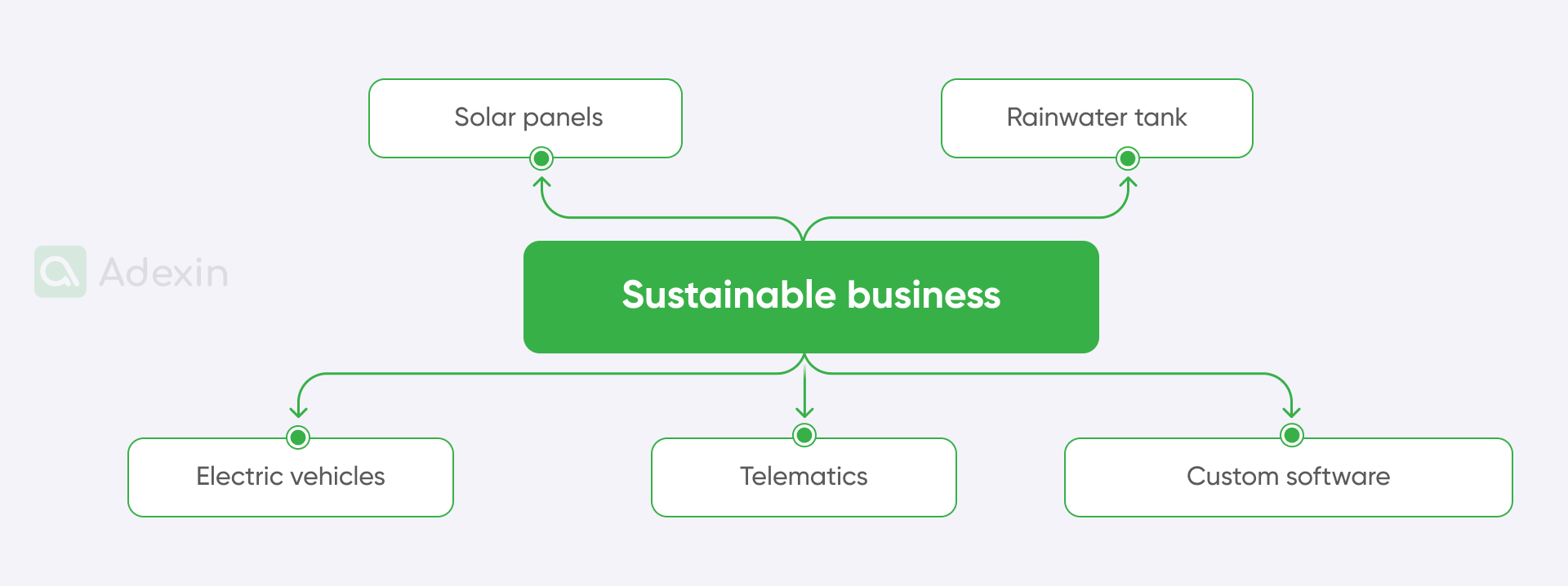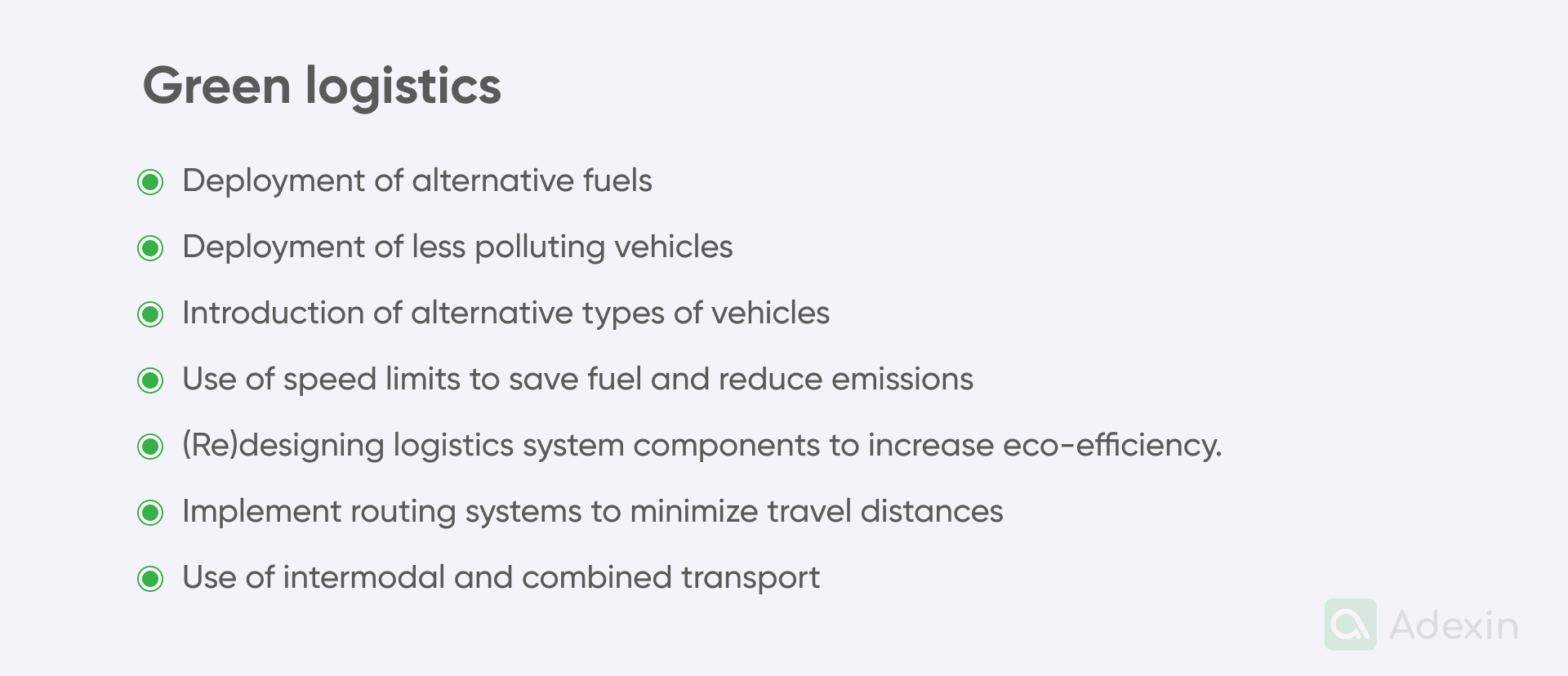Summary
This article examines the key role of sustainable practices in logistics and supply chain management. Highlighting examples such as the Spanish Red Cross and IKEA, we emphasise the importance of software solutions such as transportation management systems (TMS) and route optimization tools. Here you can see more about reducing CO2 emissions by optimizing routes and using green fuels. In general, the article underlines the impact of sustainability on companies of all sizes.
What is sustainable logistics and supply chain?
Sustainability has not only become an ongoing trend, but for many years now, it has emerged as the major challenge that companies must address. They must address it swiftly because global policies focus on sustainability and logistics, along with implementing sustainable models in the supply chain and transportation. Every company must demonstrate a certain environmental concern, making it a significant challenge.
Regardless of the innovations in the logistics, supply chain, or transportation industries, all developments will incorporate solutions toward sustainability. Irrespective of the size of the business, there is a need to comply at some level with regulations that advocate for lower CO2 emissions or the reduction of fossil fuel consumption.
It also occurs at other levels where you must present sustainable internal policies to secure contract customers. Your current and new customers may require a clear statement about your approaches to keeping your business green.
Keeping your business green means getting as close as possible to all the available sustainability models on the market. You can implement technology, such as specific equipment and custom software, to minimize energy waste and reduce CO2 emissions. Here are ways to maintain sustainable logistics, supply chain, or transportation:
Solar panels
Cover the roof of your warehouse with solar panels.
Rainwater tank
Utilize water in the heating process of the building.
Electric vehicles
Use Electric Pallet Trucks (EPTs) for internal logistics with improved batteries or trucks for transporting goods.
Telematics
Deploy equipment on your trucks that allows you to trace their performance on the road.
Custom software
Deploy completely tailored software that allows you to lower your transportation costs.
These are just a few examples of what most influences your sustainable policies to have a lesser impact on the environment. It also helps you comply with legal regulations and maintain customer retention.

What is an example of green logistics practices?
In logistics, supply chain, and transportation, we already have many examples of implementing sustainable solutions. This is because the main benefit comes from cases of cost savings. We will share more about the benefits later in this article, and for now, we present several sustainability cases in the sectors above.
Some of the cases are smaller, some of the bigger. You'll be able to see through these examples that small and medium businesses, as transportation or logistics service providers, can benefit from sustainability.
Spanish Red Cross – stock management improvement
Certain National Societies, like the Spanish Red Cross, have invested resources in enhancing their stock management to prevent waste. Regular stock counts, warehouse item rearrangements based on the latest delivery, and staff adherence to the FEFO rule are implemented. [1]
IKEA – lowering footprint emission
IKEA, a multinational furniture and home accessories company, integrates climate roadmaps into its processes to reduce material-related CO2 footprint. In their 2021 sustainability report, they achieved a 1.6 million ton reduction in CO2 equivalent to 2016 but anticipate a 5.7% increase in 2021. [2]
Worldwide carbon emission
It is also worth mentioning that some modes of transport utilize much more energy than others, and they also produce varying amounts of pollution. Here, we indicate emissions in grams of CO2 per ton transported per kilometer.
Air transport: 435g
Road transport: 80g
Rail transport: 35g
Sea transport: 5g
Looking at these points and comparing air transport with road transport, the traditional way of carrying goods seems to be still more efficient regarding sustainability. Therefore, companies emphasize special attention to optimizing this mode of transport with TMS. [1]
Lower CO2 emission based on TMS shipping
The Transport Management System (TMS) can reduce CO2 emissions by implementing a harmonized system for shipments and fleet management. TMS software can be customized according to your business needs. Initiating various green strategies begins with the utilization of TMS functionalities. One of the most crucial is the procurement functionality, enabling you to select the most suitable carrier. Many TMS systems offer this functionality, allowing you to choose a cost-effective carrier, often complemented by a procurement element where carriers and freight forwarders with green practices are highlighted.
Here are the areas that TMS can help you with lowering CO2 emission:
Deployment of alternative fuels.
Implementation of newer, less polluting vehicles.
Introduction of alternative types of vehicles (e.g., electric, hybrid).
Use of speed limits to save fuel and reduce emissions.
(Re)designing logistics system components to increase eco-efficiency.
Efficient consolidation of shipments and use of full vehicle capacity.
Implement routing systems to minimize travel distances (use of IT applications such as planning and routing software online matching systems).
Use of intermodal and combined transport.

Optimize routes for your transportation
As we already mentioned, optimizing transportation routes by deploying routing systems is one of the green policies in sustainable logistics, transportation, and supply chains. Route optimization systems are often embedded into TMS, but they can also be standalone solutions built with a perspective solely for improving routing. Very often, companies can reach for custom software development services that can also help with integrating route optimization systems with such solutions as document management and others.
Here is where a route optimization tool helps most in managing logistics, transportation, and the supply chain:
Transportation dispatch schedule.
Selecting the most suitable routes and directions
Avoiding traffic jams (reducing fuel consumption).

Implement route planner for deliveries
Implementing route planning can reduce engine idle time during pick-up and delivery processes across the country. Furthermore, it helps optimize loads and maximize space utilization in distribution containers. Transportation, logistics, and supply chain companies can use less harmful fuels.
Here is how a route planner can help you optimize delivery.
You can swiftly adapt to market changes.
You'll be able to efficiently handle seasonal demand peaks in distribution strategy.
There will be an easier way to assess the impact of mergers on route efficiency and operational costs.
You can remove some of the manual processes to boost productivity.
You can drop more focus to refine distribution processes and optimize internal resources within trailer planning.
At the end, you'll be able to benchmark driver performance against industry standards for increased productivity.
Benefits of Sustainable Logistics and supply chain management
Logistics and transportation companies today are undertaking various initiatives as part of sustainable policies. These are all connected to process improvement for supply chain management. Therefore, they are widely investing in modern software that can help collect essential information and automatically identify areas where they can propose solutions to maintaining green policies.
Here are the benefits of implementing a system for sustainable logistics and supply chain management:
Cost savings
Optimizing routes, reducing fuel consumption, and minimizing waste by fast-wearing spare parts can lead to significant cost savings in the long run.
Lower environmental impact
Green logistics practices, such as using alternative fuels and minimizing emissions, help reduce the carbon footprint.
Compliance with regulations
Following green logistics practices ensures compliance with environmental regulations and standards.
Better corporate image
Demonstrating a commitment to environmentally friendly logistics practices improves a company's reputation and can attract customers.
Operational efficiency
You can streamline processes, optimize transportation routes, and increase overall operational efficiency.
Resource conservation
Green logistics includes waste reduction, material reuse, and recycling, helping to conserve natural resources.
Innovation and competitive advantage
Adopting green logistics encourages innovation in technology and processes. It provides a competitive advantage in the market.
Risk management
Sustainable practices can reduce the risk of supply chain disruption due to environmental issues. It can provide a more resilient and flexible business model.
Better employee morale
Employees are often proud to work for companies that prioritize sustainability. It leads to increased morale and job satisfaction.
Besides these benefits for green logistics, you can enhance your business with additional capabilities by implementing some of the solutions for transport management. There are many functionalities, mostly through custom software development, that can easily support your ongoing operations and become an answer for future challenges.
Final takeaway
The biggest player in logistics, transportation, and supply chain has long embraced modern policies through software solutions. TMS has been aiding companies for years in adhering to national green policies, and it's not just a solution reserved for large corporations; small and medium-sized businesses can also benefit. Solutions for transport management or route optimization can be developed using custom software development services, which are more advantageous in the long run, offering functions not available in off-the-shelf software (COTS).
At Adexin, we help companies maintain sustainable strategies. We provide software solutions for transportation, logistics, and supply chains, supporting small and medium-sized businesses in the implementation of green policies in the work environment. Thanks to our support, companies handle business challenges more effectively and achieve faster ROI. Contact us today, and let's explore how we can improve your business.
References:
[1] Green Response Green Logistics Guide; Retrieved from: https://www.ifrc.org/sites/default/files/2023-09/20230921_GreenResponse_Logistics_NEW.pdf
[2] Green Practices in Supply Chain Management: Case Studies; Retrieved from https://dergipark.org.tr/en/download/article-file/2251369
